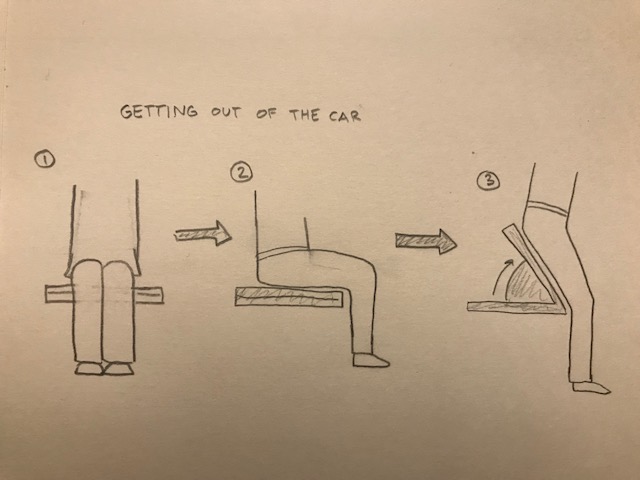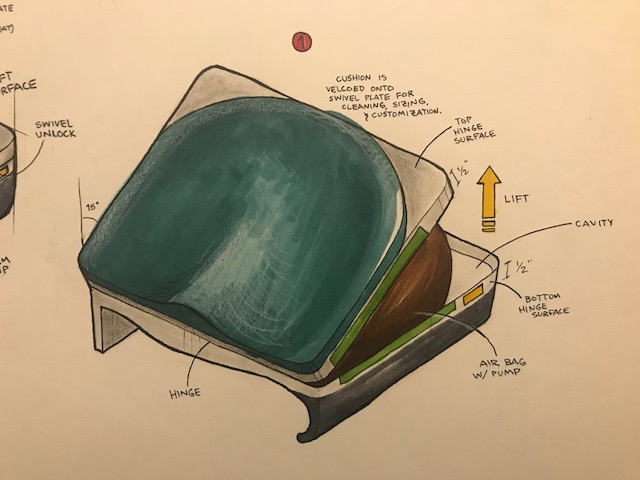- Team Lift Off – Fig 1
- Team Lift Off – Fig 2
- Team Lift Off – Fig 3
- Team Lift Off – Fig 4
- Team Lift Off – Fig 5

Team Members:
Hannah M Hoffmann, Dustin Weigl, Stephanie Schmit, Lawrence Mark Baker, and Amy Umaretiya
The Redesign:
For many elderly people, getting into and out of chairs is a difficult task. But entering and leaving cars can be even more difficult, due to lower seats and required swiveling motions. Existing solutions designed for armchairs in the home aren’t suitable for cars, because they cannot be used from the side.
Mobility is an important aspect of independence for older adults, enabling them to maintain links with family members, shop for themselves and reach support groups or hobbies. Whilst pensioners in urban areas can often use public transport, those who live in rural zones may rely on cars for transportation, either as a driver or as a passenger. It is therefore critically important that the elderly are able to enter and leave cars without hurting themselves, while maintaining dignity and independence.
Our redesign, based off existing sitting aids, aims to solve key problems:
- The lack of a swivelling motion enabling use with cars
- Insufficient assistance when beginning to stand
- Uncontrolled descent and ascent speeds
- Bulky products which would modify the optimal driving position
To remedy these issues, we propose a sitting aid which can swivel through 90 degrees so that older adults can sit into the car, before rotating themselves into a driving or forward facing position. In addition, our proposed product would make use of a pneumatic mechanism which can provide enough force to support the user’s body weight moving from a sitting to standing position or vice versa, and which is actively controlled by the user throughout the standing and sitting process. Since the mechanism is able to deflate entirely once the user is seated, it has a low profile, maintaining driving position and comfort. Using an airbag allows this product to become exceptionally flat, which also allows it to be a relatively unnoticeable addition to the car seat. We foresee this product not only to be used in personal vehicles, but rideshare vehicles such as Uber and Lyft that want to expand their customer base. The design allows rideshare passengers who don’t need assistance to use the seat like a normal seat as well.
How human-centered and human-factors concepts guided your team:
Our original design idea was motivated by personal experience with hip problems and the knowledge that our elderly relatives had issues sitting and standing. We verified our initial product concept by speaking with grandparents of team members. They confirmed that the car presents a particularly difficult challenge for them because it requires a good deal of strength and flexibility relative to regular chairs. They agreed that this would be a useful product for both them and their friends who are confronted with issues relating to personal mobility.
We then drew basic sketches of our design and compiled an approximate bill of materials, before performing a task analysis walkthrough to identify considerations that we may have missed. This was a fruitful exercise which involved several new features (controls being mounted on a remote rather than out of reach on the base of the product), a modified layout and new failure modes being identified.
We have kept our target audience in mind throughout the design process – with a particular focus on making controls easy to use for the elderly. The final design features a sprung rocker switch (similar to those used for electronic car windows) for control over raising and lowering, and a simple button to release automatic locking after the user has fully rotated.
Aware that there is great variation in the body types of elderly people, we have chosen an actuation system (pneumatics) which can scale easily to higher forces. In addition, the upper cushion could easily be made detachable and we envisage a range of different sizes and firmnesses being sold to accommodate different body shapes. Car manufacturers have already optimized the driving environment using anthropometric measurements; we have created a product which mimics those dimensions and adds just a couple inches on top of the existing seat cushion while in the driving position. This ensures that we do not compromise the intended design and its subtlety also maintains the dignity of the user.
Driving is a safety critical activity, so we have tried to avoid introducing new failure modes to driving. The sitting aid is secured to the seat using a rigid panel positioned against the sitting angle, a rubber panel to pull over the seat side to allow for variable car seat widths, non-slip feet. The product automatically locks, preventing unwanted rotation or upward force during driving. Product-specific failure modes have also been accounted for. It would be easy for a user to trap their hands in the device as it closed, and so the edges will be covered using textiles and lined with thick, compliant foam, which will prevent any significant pinching forces.
The product status is also actively communicated – as well as clear visual cues, lights and tones indicate when the product has reached the end of its range of motion. An engaged interlock is made clear through an LED display and a button which has different positions for ‘on’ and ‘off’. Recognition and recall are not expected to be problematic because the product mimics a process already familiar to users, providing mechanical assistance to make their life easier.
Further testing needs to be conducted to highlight any unforeseen errors, explore expected problems (particularly tall users may bump their heads upon entering the car) and to clarify the technical specifications of the product. In particular, the optimal speed for standing and sitting cycles and the minimum trip length (which affects charging time).




